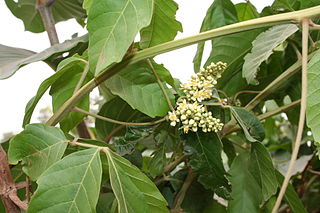
James Mitchell Tour is an American chemist and nanotechnologist. He is a Professor of Chemistry, Professor of Materials Science and Nanoengineering, and Professor of Computer Science at Rice University in Houston, Texas. Tour is a top researcher in his field, having an h-index of 165 with total citations index over 125,000 and was listed as an ISI highly cited researcher.

Lanosterol is a tetracyclic triterpenoid and is the compound from which all animal and fungal steroids are derived. By contrast plant steroids are produced via cycloartenol.
In organic chemistry, an intramolecular Diels-Alder cycloaddition is a Diels–Alder reaction in which the diene and a dienophile are both part of the same molecule. The reaction leads to the formation of the same cyclohexene-like structure as usual for a Diels–Alder reaction, but as part of a more complex fused or bridged cyclic ring system. This reaction gives rise to various natural derivatives of decalin.

A depside is a type of polyphenolic compound composed of two or more monocyclic aromatic units linked by an ester group. Depsides are most often found in lichens, but have also been isolated from higher plants, including species of the Ericaceae, Lamiaceae, Papaveraceae and Myrtaceae.

Oroxylin A is an O-methylated flavone, a chemical compound that can be found in the medicinal plants Scutellaria baicalensis and Scutellaria lateriflora, and the Oroxylum indicum tree. It has demonstrated activity as a dopamine reuptake inhibitor, and is also a negative allosteric modulator of the benzodiazepine site of the GABAA receptor. Oroxylin A has been found to improve memory consolidation in mice by elevating brain-derived neurotrophic factor (BDNF) levels in the hippocampus.
Cāng zhú, also known as black atractylodes rhizome or Rhizoma Atractylodes, is a Chinese herbal medicine. It is the dried rhizome of Atractylodes lancea (Thunb.) DC., synonyms Atractylodes chinensis (DC.) Koidz, and Atractylodes japonica Koidz. The medicine is distinguished from bái zhú, which is typically cultivated, whereas cāng zhú more often tends to be collected from the wild. It is believed that the distinction between cāng zhú and bái zhú emerged in relatively modern times; a single drug "zhú" described in the Shen nong ben cao jing probably included many Atractylodes species.
Gary Martin is an American chemist and expert in the fields of both NMR spectroscopy and medicinal chemistry. He is a distinguished fellow at the Merck Research Laboratories. He is also a photographer specializing in the capture of images of lighthouses, especially under conditions of extreme weather.

A quinone methide is a type of conjugated organic compound that contain a cyclohexadiene with a carbonyl and an exocyclic methylidene or extended alkene unit. It is analogous to a quinone, but having one of the double bonded oxygens replaced with a carbon. The carbonyl and methylidene are usually oriented either ortho or para to each other. There are some examples of transient synthetic meta quinone methides.

4′,7-Dihydroxyflavone is a flavone. It is found in Medicago truncatula in relation with the root nodulation symbiont Sinorhizobium meliloti or in seeds of Sophora viciifolia.

Paullinia pinnata is a flowering plant species in the genus of Paullinia found in South America and Africa.

(S)-Magnoflorine is a quaternary benzylisoquinoline alkaloid (BIA) of the aporphine structural subgroup which has been isolated from various species of the family Menispermaceae, such as Pachygone ovata,Sinomenium acutum, and Cissampelos pareira.

Polyfothine is an anticholinergic alkaloid.

Phakellistatin 13 is a cytotoxic cycloheptapeptide isolated from marine sponge.

14-Norpseurotin A is an alkaloid and a bio-active metabolite of Aspergillus, featuring an oxa-spiro-lactam core.
Fungal isolates have been researched for decades. Because fungi often exist in thin mycelial monolayers, with no protective shell, immune system, and limited mobility, they have developed the ability to synthesize a variety of unusual compounds for survival. Researchers have discovered fungal isolates with anticancer, antimicrobial, immunomodulatory, and other bio-active properties. The first statins, β-Lactam antibiotics, as well as a few important antifungals, were discovered in fungi.

Pawhuskin A is a naturally occurring prenylated stilbene isolated from Dalea purpurea which acts as a competitive silent antagonist of the κ-, μ-, and δ-opioid receptors. The compound was named after Pawhuska, Oklahoma, a place near where the samples of Dalea purpurea that led to its discovery were taken from. Other isolates of the plant with affinity for opioid receptors include Pawhuskin B and Pawhuskin C, though these compounds produce comparatively weak opioid receptor displacement relative to Pawhuskin A. Dalea purpurea was used in traditional Native American medicine to treat various ailments, and pawhuskin A and related isolates may be some of the constituents of the plant which underlay this use.

Tellimagrandin I is an ellagitannin found in plants, such as Cornus canadensis, Eucalyptus globulus, Melaleuca styphelioides, Rosa rugosa, and walnut. It is composed of two galloyl and one hexahydroxydiphenyl groups bound to a glucose residue. It differs from Tellimagrandin II only by a hydroxyl group instead of a third galloyl group. It is also structurally similar to punigluconin and pedunculagin, two more ellagitannin monomers.

Stephen L. Craig is the William T. Miller Professor of Chemistry at Duke University. He is the director of the Center for Molecularly Optimized Networks, a NSF Center for Chemical Innovation.

Cycloartane is a triterpene, also known as 4,4,14-trimethyl-9,19-cyclo-5alpha,9beta-cholestane. Its derivative cycloartenol is the starting point for the synthesis of almost all plant steroids.

Euphane is a tetracyclic triterpene that is the 13α,14β-stereoisomer of lanostane. Its derivatives are widely distributed in many plants.

















